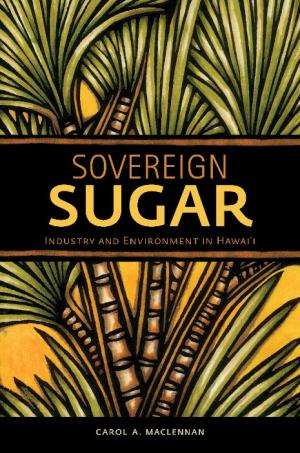The Rise and Fall of Sugar in Hawai'i

There's one sugar plantation left in Hawai'i, just a few square miles left of an industry that once dominated the island chain. Sugar's profits and high-paying jobs are long gone, as are the native forests and sustainable farms it devoured, thanks to a "voracious need for land and water." In her new book, "Sovereign Sugar: Industry and Environment in Hawai'i," Carol MacLennan describes the rise and eventual fall of the sugar planter elite and its consequences, both for the people of Hawai'i and the land itself.
MacLennan began studying the Hawaiian sugar industry in the 1970s, when she was a graduate student at the University of California at Berkeley. "I was looking at a sugar plantation community that was being shut down and how people dealt with the dislocation," she said. "It was the beginning of the wave of dislocations. Now, sugar is gone, and pineapple is gone. Just one little plantation is operating."
In her book, she expands her scope, carving out a 100-year period from the 1840s to World War II. "Sovereign Sugar" tracks the beginnings of the sugar industry until its height, when virtually all the forests at elevations where sugar could grow had been razed and the land planted to cane.
"I wanted to look at industrialization of the islands, wanted to see how it affected landscapes—forests, water and soils, as well as changes in the community, demographic changes," MacLennan said. "Sugar was in control of the land, and it also controlled the politics. People lived on plantations or were in service to sugar. Everything was centralized."
The sugar elite, a consortium of five companies originally formed by American missionaries, held such power that they could orchestrate the overthrow of the Hawaiian constitutional monarchy. Perhaps even more importantly, they convinced the native Hawaiians to give up their communal property rights. Later, a single union, the International Longshoremen and Warehousemen Union, held sway. "Powerful and progressive, they turned the tide toward the Democrats, and Hawai'i has been Democratic since statehood," MacLennan said.
Sugar wasn't the first wave of change to hit the islands, MacLennan notes. The original Polynesian settlers brought livestock and hunted some species to extinction. But nothing was quite like sugar. "It had a totalizing effect," she said. "To plant cane, they scraped the environment free of vegetation, often recontouring the land. All the indigenous forests, with incredibly complex ecosystems that were the home of many species, were logged, except those high on the mountains."
Even the high mountains weren't spared, since the plantations captured their water for irrigation. But when the companies realized that they were destroying the forests and, along with them, their precious water, they began reforms that formed the foundation of what would essentially be the first agricultural extension service.
Though global markets led to the end of sugar in Hawai'i, "sugar's ghost continues to frequent the islands with its legacy of economic dominance," MacLennan writes.
That legacy has lessons to teach us, she says, if we will pay attention.
"First, there is the lesson of islands and their limitations," MacLennan said. Islands, with their limited resources and often-fragile ecosystems, impose limits, and not just on industry. They can "easily cascade into places unsuitable for human survival."
Second, culture matters. Hawai'i's success as a trading hub and prosperous, progressive nation, territory and state grew from the rich cultural mix that arose from the mingling of the native population with immigrant missionaries and Asian workers.
"The power of changing property regimes teaches an important third lesson," MacLennan says. When sugar barons introduced the Western concept of property, it had devastating consequences for the indigenous Hawaiians' social order. She suggests that these changes might be reversed in similar scenarios. The key factor is the survival of those who remember the original order.
Finally, MacLennan notes, you can't have everything. The full might of Western agribusiness created temporary prosperity—in the form of high profits and good jobs—at the price of the sometimes irreversible destruction of island ecologies.
"As we shift our sights from economic priorities to environmental consequences that challenge the continuation of island life and livelihood, our eyes refocus," she concludes. "What we learn from the past may be most important for Hawai'i's future."
Provided by Michigan Technological University




















